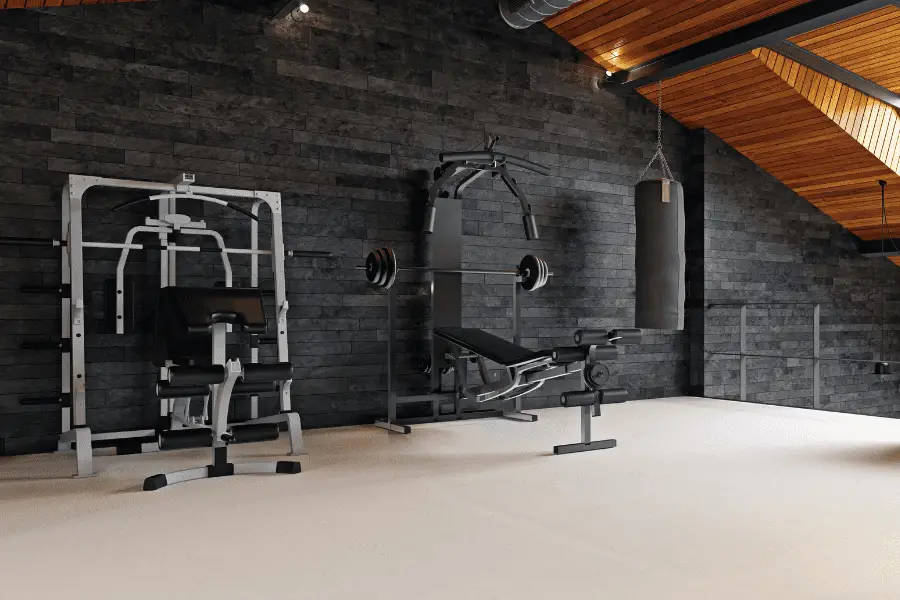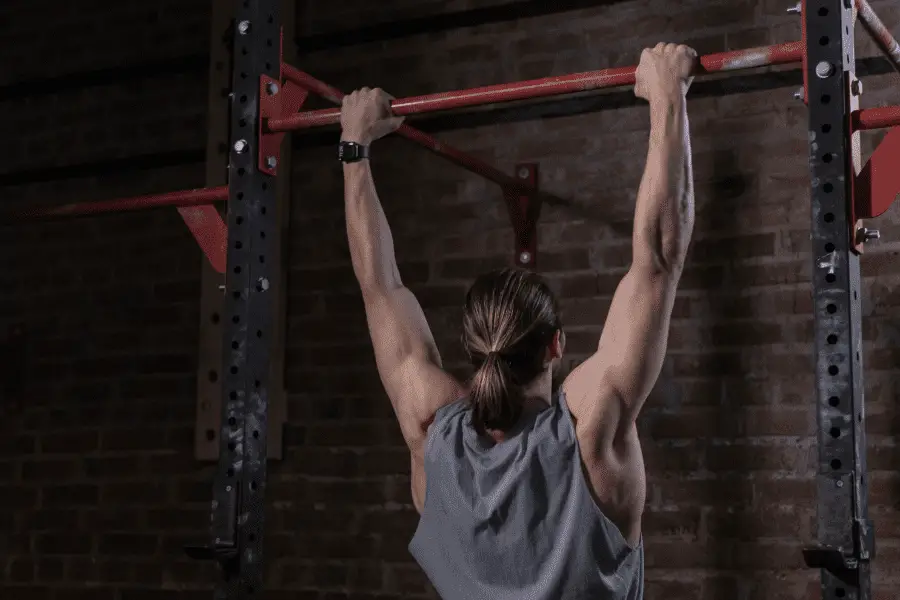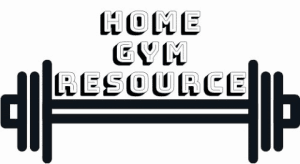A power rack is undeniably a substantial piece of gym equipment, and not everyone has the luxury of accommodating it in their home gym. Or maybe it just doesn’t fit into your budget. So can you get away without using a power rack? In this article, we’ll figure out what you need a squat rack for and how you can replace it.
It’s not difficult to create a fully functional home or garage gym without a power rack. A full rack can be replaced with squat stands or a folding rack. Even without any barbell rack, it’s possible to replace the lifts you need a rack for with alternative exercises.
How you can do this properly and which alternative exercises are proper replacements without getting any other equipment? Keep reading to find out.
Contents
Is a Home Gym Possible Without a Power Rack?
We get it, not everyone has the luxury of space or budget to accommodate a full-sized power cage in their home gym.
Not all types of workouts need them. You need a squat cage to do a certain set of exercises where it’s important that the barbell is held at a height where it’s easy to use. They also add safety. If you don’t do any of those exercises, there’s no need. And there are some alternative
So, let’s explore what these racks brings to the table and how you can craft a fully functional home gym without the need for one.
Understanding the Role of a Squat Rack
Before we dive into creating a power rack-free home gym, let’s take a look at the versatility a power rack offers.
A power rack, also known as a power cage or squat rack, offers several benefits for individuals looking to build strength and improve their fitness in a safe and versatile manner. Here are the key advantages of using a power rack in your home gym:
Key Squat Cage Exercises
In an ideal home gym setup that includes a power rack, you can find a variety of essential exercises. Here are some of the most common exercises performed in a power cage:
At least some of these movements will be found in pretty much every workout routine so you can understand why the squat cage is such a popular and important piece of equipment.

What Doesn’t Require a Power Rack?
Well, quite a bit, actually. Let’s break it down:
- Cardio: Cardio workouts don’t rely on a rack, and you can incorporate various forms of cardio without it.
- Dumbbell Exercises: A vast array of dumbbell exercises can be seamlessly integrated into your routine without the need for any rack.
- Barbell Exercises from the Floor: Movements like deadlifts and rows, which start from the floor, don’t necessitate a power rack.
- Stretching: You can comfortably dedicate space in your home gym for stretching routines, independent of a power cage.
While you can still do a lot of effective lifts and exercises without a power rack, you can see that in terms of strength and muscle building, you’re a little limited, which is why so many home gyms have a rack.
What are the alternatives to a squat rack?
Is there another way to still be able to do those lifts without a full power rack? Sure there is. The alternatives can roughly be divided into two categories;
- Alternative equipment
- Alternative lifts
What do you want from alternatives?
They should functionally be the same. So, exercise the same muscles. Have the same movement patterns. The equipment shouldn’t take up any more space than a power cage otherwise it would be pointless to not get the squat rack in the first place.
Squat Cage Alternative Equipment
The easiest way to still be able to perform all the lifts is to get equipment that does the same thing. As long as it doesn’t take up as much space as a power rack, it just might work for you. So what options are there?
Squat stands, a half rack, or a folding rack can serve as excellent alternatives to a full power cage (power rack) in a home gym, offering similar benefits while addressing specific needs or space constraints. Here’s how each of these alternatives can be effective:
1. Squat Stands
Squat stands are a pair of upright metal stands that provide support for barbell exercises such as squats, bench presses, and overhead presses. They are typically height-adjustable.
Some squat stands are independent which means you just get two separate uprights. Some are connected by a brace at the bottom.
If you have space to use a barbell in your gym, you’ve got space for a pair of these. And after use, they’re pretty easy to move out of the way.
If you choose squat stands, I’d recommend getting a separate pull-up bar.
A pull-up bar is a small piece of equipment that allows you to do pull-ups and chin-ups. Especially in a home gym, it’s hard to find alternative exercises that fully replace the pull and chin up so a pull-up bar is an easy and cheap way to still be able to do them while taking up very little space.
2. Half Rack
A half rack is a sturdy metal frame that resembles half of a full power cage. It often includes safety spotter arms, J-hooks, and pull-up bars. Some models offer attachment points for additional accessories.
3. Folding Rack
A folding rack is a wall-mounted metal frame that can be folded against the wall when not in use. It provides stability and safety for various barbell exercises and often includes attachment points for accessories.
You’ve got a variety of these folding racks. Most are just two upright posts so they resemble a half rack. However, there are folding racks with four posts so they’re a complete cage.

With those pieces of equipment, you can do all the same lifts that you can in a full power rack. You’ll be able to squat, OHP, bench press, etc.
Yes, there are some downsides like reduced safety, stability, and add-ons. But, you do save quite a bit of space and in some cases also money. It’s up to you what you’re willing to compromise on.
Alternative Movements Without a Squat Rack
What if you just can’t have any type of rack or barbell stand? Then we have to replace the movement patterns with alternative exercises. Let’s go through the different movement patterns and see how we can replace them with either other barbell exercises or with other types of movements.
Let’s assume we still have the basic weightlifting equipment minus the squat cage. What can we do with that?
What we’re left with is;
- Barbell: Without a rack, you can still use a barbell for a lot of exercises.
- Weight Plates: For on the barbell
- Bench: Even without a barbell, the bench is still a very useful piece of equipment for use with dumbbells.
- Dumbbells: Dumbbells are a great tool as an alternative to barbell exercises. While some alternative exercises don’t exactly have the same movement pattern as the original but require largely the same muscles.
Luckily there are a ton of things you can do with just those pieces of equipment.
Exercise | Best Alternative | Other Alternatives |
|---|---|---|
| Squat | Barbell Landmine Squat | Dumbbell Goblet Squat, Lunges, (Bulgarian) Split Squats |
| Overhead Press | Power clean the bar from the floor, then press as usual. | Dumbbell Shoulder Press |
| Pull/Chin-Up | Pull-up bar | Resistance Band Pulldowns |
| Bench Press | Dumbbell Press | (Deficit) Push Ups, Banded Push Ups, Floor Press. |
Squats Without a Power Cage
If you want to use a barbell to squat, the best option is the landmine squat. You put one end of the bar in the landmine attachment, and load the other end. Then grab the part of the sleeve that’s not loaded and squat.
You can get a reasonable amount of load this way and the movement pattern is very similar to the barbell back squat although it stresses the lower back less. You can also increase the weight quite easily. The maximum load is a little limited though since you can only load one side of the barbell.
Other good alternatives are the dumbbell goblet squat, lunges, and split squats.
Overhead Pressing Without a Squat Rack
The best barbell alternative to the overhead press is the clean and press. This makes the lift a lot more technical and will require a bit of practice and maybe getting some coaching is a good idea. Once you master the movement, you can just clean the weight to your chest and then overhead press like normal.
This gets more difficult the heavier the bar gets but with some practice, most people can clean more than they can press so it’s not a limiting factor.
Dumbbell shoulder presses are actually a very good alternative. Research shows that the DB shoulder press activates your shoulder more than barbell overhead pressing although you’ll have to use a lighter weight.
Pull-ups Without a Squat Cage
In most home gyms, the pull-up bar is built into the rack. If you don’t have a rack, or yours lacks a bar, the best way to get around this is to get a separate pull-up bar. A good doorway-mounted bar is cheap and works.
The pull-up is a hard exercise to replace with other equipment. Sure you could do heavy lat-pulldowns but you need an even larger machine for that. A separate pull-up bar is the easiest and bets way to go.
Here is the pull-up bar I recommend for home gyms.
Resistance band pulldowns are an option if you can find a spot to anchor your resistance bands above your head. No, you can’t do these as heavily as pull-ups but the movement pattern is very similar. If you do these heavy, you’ll either lift yourself off the floor, turning it into a pull-up again but it’s more likely that the anchor or resistance band won’t hold your weight.
Bench Pressing Without a Power Rack
Without any type of rack, doing barbell bench pressing is just not practical. Especially once the weights get heavier.
Conclusion
In conclusion, building a functional home gym without a power rack is entirely possible. While a power rack offers various advantages in terms of safety, versatility, and ease of use, there are viable alternatives available that cater to different needs and space constraints.
You can either replace the full rack with more compact, cheaper alternatives or find exercises that train the same muscles.
FAQ
Do you need a power rack to bench press?
To do a proper barbell bench press in your home gym, you need a bench, barbell, weights, and a barbell stand or power rack. A power rack with safety pins is the safest option in a home gym where you usually work out alone. Alternatively, you can do dumbbell bench presses or floor presses.

